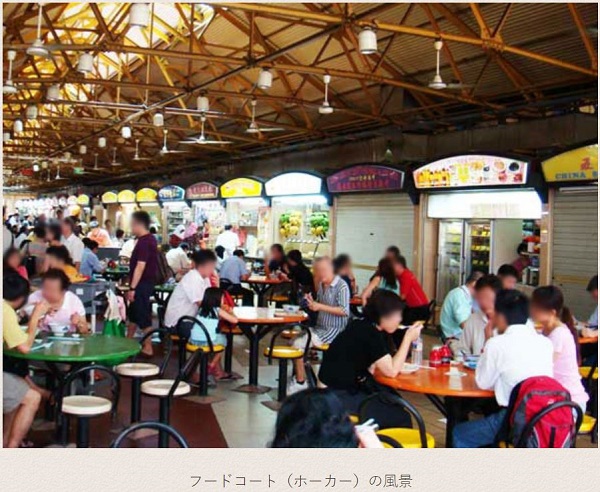<Report from overseas office> [Singapore] Housework in Singapore - outsourcing
- Release date: Apr 03, 2020
- 11696 Views

Out-sourcing of food preparation
In Japan, there still seems a strong belief that it is desirable to eat homemade meals. (Although in reality, we are getting looser and looser in terms of what is considered to be "homemade")In Singapore, you won't find that same kind of custom or tradition as in Japan. Instead, UberEats-like food delivery services such as Grab, FoodPanda and Deliverloo are competing with each other. There are many food courts or casual dining restaurants as well as inexpensive takeout. You get to choose what to eat from various types of foods, and in many places the portion size is large and you can get enough amount of veggies to get you through the day. You'll often see people with their children eating at the food court.
(On a different note, I'm guessing that the existence of a food court is what makes Seven-Eleven's chilled section less attractive than in Japan.)

% of household who employ house keeper(s)/maid(s)_4 countries

*1: 内閣府「家事労働者の雇用について」 Retrieved April 3, 2020, https://bit.ly/3ccIkM6)[https://bit.ly/3ccIkM6] *2: Singapore Department of Statistics (DOS)Resident Households by Household Characteristics and Deciles, 2000 - 2019 Retrieved April 3, 2020, (https://bit.ly/3dph3W6)[https://bit.ly/3dph3W6] *3: 労働政策研究・研修機構「マレーシアの労働政策」 Retrieved April 3, 2020, (https://bit.ly/3fNBXj3
% of household who employ house keeper(s)/maid(s)_4 countries
In Japan, using housekeeping services considered a luxury for the wealthy class, but in Singapore, middle class people are commonly using the services. Speaking of myself, there are only two people, my husband and I, in my household and I am a minimalist wannabe, so I don't feel the need to hire a housekeeper at all. However, my co-worker with two small children says, "It would be really hard without our housekeeper!”The reason for this is that the Singapore government introduced the Foreign Domestic Servant Scheme in 1978 as part of its efforts to promote the employment of women in Singapore. It was the first law in the world to allow for the issuance of special visas for the job of housekeeper, and women from the Philippines, Myanmar and other neighboring Asian countries began to work as household workers. (The Singapore government proactively introduces measures to promote the employment of foreign workers, rather than leaving it to companies.)
Below is the employment rate of women by age group in each country. As a result of the government's efforts, Singapore has a higher rate of women in the workforce compared to other countries. The market rate for using housekeeping services is 80,000 yen per month, which is an unbeatable price for the Japanese way of thinking, even though they provide 3 meals and housing. Most housekeepers are hired by households with children or elderly people. The work is very diverse: cooking, cleaning, and taking care of the children. There is a day care center on the second floor of the building where our company is located, and when I come to work in the morning, I often see a Filipino housekeeper bringing a Chinese Singaporean child with her.
In Japan, it is said that the average price of hiring a live-in housekeeper is 18,000 yen per day, which is not an amount of money that a middle-class family can ever afford.
Because of that reason, we have to do everything within our family, but I think there's a sense of guilt lingering in our minds that “we have to do it properly, but we really can’t get it done.”
What happens when housework is out-sourced
INTAGE is collecting consumer purchase log data (SCI) for packaged goods with JAN codes in Japan. There are several obstacles to overcome when trying to do this in Singapore.First of all, the fact that people often eat out and eat ready-made meals at home means that they don’t go and purchase packaged foods or beverages at supermarkets. In Japan, if you analyze the SCI, you can get an idea of what kind of foods or beverages are currently popular along with the future trends, but in Singapore, you cannot figure it out unless you understand the actual status for what people eat out and what kind of ready-made meals they eat at home.
Dues to the presence of a housekeeper, the person who decides which product to purchase and the person who actually goes to the store and purchase are sometimes different. This means that a higher percentage of products are already decided before the store visit than in Japan. In this regard, brand switching is less likely to occur because it is more difficult to induce an impulse purchase such as a "pake-gai (purchase affected by the package) ".
Since the purchase-decision maker does not actually cook or clean themselves, products with a selling point such as "Without scrubbing over and over again” or “No need to bend your knees to reach that dirt" wouldn’t always be appealing (because the purchase-decision makers won’t do the work).
Instead, I think it would be more appealing to promote basic functions such as "Removing more dirt" or "Gives better taste". Also, in Singapore, products are imported as they are from other countries and are sold with raw material stickers on the back. In this regard, supermarkets may need to get creative with their product stickers and point-of-sale (POP) advertising on the back of their products.
Rather than leaving it to the housekeeper, some people still do their major weekly shopping by themselves, so the above is not a blanket statement, but I think there are some different factors that affect consumer purchase decision compared to Japanese shopper.
-

Author profile
Ms. Noe Suhara
It's been about six months since I transferred to Singapore. I was in charge of food and beverages in Japan for a long time and I like to eat, so I'm very interested in the trends in that area. My favorite foods are crunchy thin fries and café lattes. Since coming to Singapore, I've been consuming a lot of jackfruits and sake.
-

Editor profile
Ms.Risa Takahama
I have been involved in overseas marketing research for consumer goods manufacturers, mainly in Asia, and is currently developing research solutions to guide the insights of overseas consumers. Whenever I travel abroad, I always stop at a drugstore to buy cosmetics that are unique to that country.
 Global Market Surfer
Global Market Surfer CLP
CLP